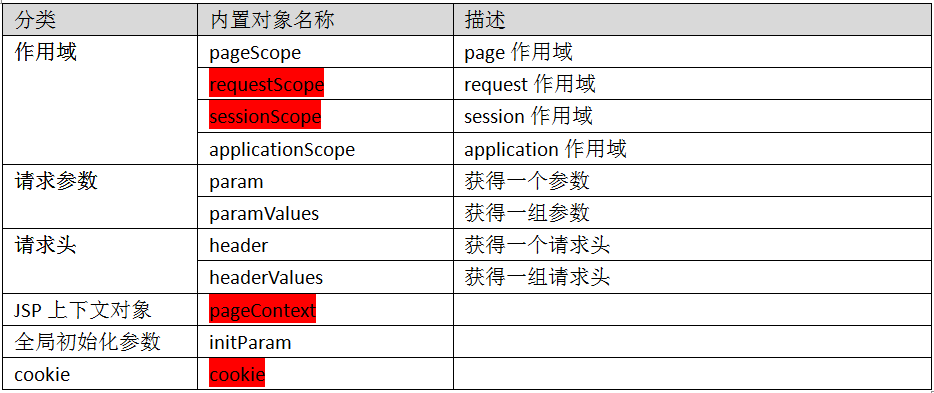一、EL表达式
1、el 表达式语法
EL表达式的语法非常简单,都是以“${”符号开始,以“}”符号结束的,具体格式如:${表达式}
2、el 表达式的内置对象
3、el 表达式获取四个域对象中的值
(1)、存值
<%
//向JSP中的4个域对象赋予值
pageContext.setAttribute("name", "pname");
request.setAttribute("name", "rname");
session.setAttribute("name", "sname");
application.setAttribute("name", "aname");
%>(2)、取值
<h1>JSP传统脚本段的方式获取数据</h1>
<%=pageContext.getAttribute("name") %><br/>
<%=request.getAttribute("name") %><br/>
<%=session.getAttribute("name") %><br/>
<%=application.getAttribute("name") %><br/>
<%=application.getAttribute("myname") %><br/>
<h1>EL表达式获取4个域对象中的数据</h1>
${pageScope.name}<br/>
${requestScope.name}<br/>
${sessionScope.name}<br/>
${applicationScope.name}<br/>
${name}<br/>
${myname}<br/>4、el 表达式获取表达或者url中参数,并回显
(1)、获取参数
<h1>通过EL获取到表单参数</h1>
${param.username}<br/>
${param.hobby}<br/>
${paramValues.hobby}<br/>
${paramValues.hobby[1]}<br/>(2)、回显数值
<form action="/day40/LoginServlet" method="post">
user:<input type="text" name="username" value="${param.username}"/><br/>
pass:<input type="password" name="password" value="${param.password}"/><br/>
<button>提交</button>
</form>5、el 表达式获取请求头中的数据 -- 了解内容
${header.accept} <br/>
${header.accept-Encoding} <br/> <%--非法的,有异常,“-”被解析成减号。使用"/"进行单个el表达式转义 --%>
${header['accept-Encoding']} <br/>
${headerValues['accept-Encoding'][0]} <br/>6、el 表达式获取项目路径 -- 重点
<img src="${pageContext.request.contextPath}/01_EL/a/b/images/11.bmp"/><br/>
<a href="${pageContext.request.contextPath}/a/b/b/login.jsp">登录页面</a>7、el 表达式获取web.xml中初始化配置参数
${initParam.username }<br/>
${initParam.password }<br/>8、el 表达式获取cookie中的数据
(1)、获取cookie中数据
<!--
Cookie[] cks=new Cookie[3];
cks[0]<====>cookie对象
cks[1]<====>cookie对象
-->
${cookie}<!-- 获取到所有的cookie --><br/>
${cookie.name01}<br/>
${cookie.name01.name}<br/>
${cookie.name01.value}<br/>(2)、记住用户名
<form action="/day40/LoginServlet02" method="post">
User:<input type="text" name="username" value="${cookie.username.value}"/><br/>
<input type="checkbox" name="remUser" value="true"/>记住用户名<br/>
<button>登录</button>9、el 表达式获取集合、对象中数据
<title>el获取各种数据_字符串_数组_集合_MAP_普通JAVAbean对象</title>
</head>
<body>
<h1>PS:el获取的是指定范围内的数据(4个域对象,表单参数,cookie,请求头)</h1>
<hr/>
<h3>el获取字符串</h3>
<%
String str02="my name is mary!";
pageContext.setAttribute("myStr02", str02);
%>
${myStr02}
<hr/>
<h3>el获取java对象中的数据</h3>
<%
User uu=new User("lucy","55555");
pageContext.setAttribute("myUser", uu);
%>
<!--
当JSP引擎 识别到 ${myUser} ,底层从4个域对象范围寻找属性名为myUser对应值(对象引用),
当获取到这个对象时 ${myUser.username} 调用对象上的getUsername()方法.
-->
${myUser.username}
${myUser.password}
<hr/>
<h3>el获取数组中的数据</h3>
<%
String[] arr={"aaaa","bbbb","cccc"};
request.setAttribute("myArr", arr);
%>
${myArr}<br/>
${myArr[2]}<br/>
<hr/>
<h3>el获取集合中的数据</h3>
<%
List<String> list=new ArrayList();
list.add("111111");
list.add("222222");
list.add("333333");
request.setAttribute("myList", list);
%>
${myList}<br/>
${myList[2]}<br/>
<hr/>
<h3>el获取MAP中的数据</h3>
<%
Map<String,User> map=new HashMap<String,User>();
map.put("uu01", new User("张三","2121"));
map.put("uu02", new User("土豪","2122"));
map.put("uu03", new User("李四","2123"));
request.setAttribute("myMap", map);
%>
${myMap} <= = => pageContext.findAttribute("myMap"); <br/>
${myMap.uu01}<br/>
${myMap.uu01.username}<br/>
${myMap.uu01.password}<br/>
<hr/>
</body>运算结果:
10、el 表达式的运算符
<title>EL对运算符支持</title>
</head>
<body>
PS:EL表达式: 用运算符将常亮,变量,表达式连接起来的符合EL语法规则的式子<br/>
三大运算符: 算术,关系,逻辑,三元,非空<br/>
<%
User user=new User();
pageContext.setAttribute("myUser", user);
pageContext.setAttribute("n1", "10");
pageContext.setAttribute("n2", "20");
pageContext.setAttribute("n3", "30");
pageContext.setAttribute("n4", "40");
%>
<h1>el 算术运算符</h1>
${ n1 + n2 + n3 }<br/>
${1+1} <br/>
${"1"+1} <br/> <%--将字符串转换成数字,然后进行计算 --%>
${'1'+1} <br/> <%--el没有字符 --%>
\${'a'+1} <br/> <%-- 将a转换数字,异常 --%>
${a + 1} <br/> <%--a将从作用域获得数据,如果没有 --%>
<h1>el 关系运算符</h1>
${ n1 < n2 } - ${ n1 lt n2 } <!-- less than --><br/>
${ n1 > n2 } - ${ n1 gt n2 } <!-- great than --><br/>
${ n1 <= n2 } - ${ n1 le n2 } <!-- less equal --><br/>
${ n1 >= n2 } - ${ n1 ge n2 } <!-- great equal --><br/>
${ n1 == n2 } - ${ n1 eq n2 } <!-- equal --><br/>
<h1>el 逻辑运算符</h1>
${ n1<n2 && n3<n4 } - ${ n1<n2 and n3 < n4 }<br/>
${ n1<n2 || n3 < n4 } - ${ n1<n2 or n3 < n4 }<br/>
${ !(n1 < n2) } - ${ not(n1<n2) }
<h1>el 三元运算符</h1>
${n1>n2?"AAAA":"BBBB"}
<h1>el 非空运算符</h1>
${empty myUser}<br/>
${not empty myUser}<br/>
</body>二、JSTL表达式
1、什么是JSTL
标准标签库(JavaServer Pages Standard Tag Library),简称JSTL。
2、JSTL标签库
三、JSTL的使用
1、导入jar包
2、引入标签
<%@ taglib uri="http://java.sun.com/jsp/jstl/core" prefix="c" %> 3、if 标签的使用
<h1>测试if标签</h1>
<c:if test="${3>2}">
AAAAAAAAAAAAAA
</c:if>
<c:if test="${3<=2}">
BBBBBBBBBB
</c:if>4、forEach 标签的使用
var:属性用于指将当前迭代到的元素保存到page域中的名称;
items:属性用于指定将要迭代的集合对象;
varStatus:用于指定当前迭代状态信息的对象保存到page域中的名称;
begin:属性用于指定从集合中第几个元素开始进行迭代,begin的索引值从0开始,如果没有指定items属性,就从begin指定的值开始迭代,直到迭代结束为止;
step:属性用于指定迭代的步长,即迭代因子的增量。
(1)、方式1
<h1>测试for each标签_方式1</h1>
<!--
以下代码:代替了JSP脚本段 for循环 含义: 从1循环到50,将每次的值放入i中,步长为2 , ${i}将i中的值,依次输出
varStatus="status" :代表循环过程中的一些中间状态值
status.index: 正在输出数字下标
status.count: 当前循环的次数
status.first: 当前正在输出元素是否是第1个元素
status.last: 当前正在输出元素是否是最后一个元素
-->
<c:forEach begin="1" end="50" var="i" step="2" varStatus="status">
${i} <==> ${status.index} <===> ${status.count}<===> ${status.first}<===> ${status.last}<br/>
</c:forEach>(2)、方式2
<h1>测试for each标签_方式2(频繁使用)</h1>
<!--
items="${allUsers}": 说明当前我们要遍历数据范围
var="uu" 将正在遍历的数据依次赋值给变量uu
-->
<c:forEach items="${allUsers}" var="uu" varStatus="status">
${status.count}<===>${uu.username}<===>${uu.password }<br/>
</c:forEach>5、遍历字符串数组和map集合中的数据
<h1>测试for each标签_方式2(频繁使用)</h1>
<!--
测试JSTL遍历字符串数组_MAP中的数据
-->
<%
String[] arr={"1111","22222","33333"};
pageContext.setAttribute("myArr", arr);
Map<String,User> map=new HashMap<String,User>();
map.put("uu01", new User("tom1","1234"));
map.put("uu02", new User("tom2","1235"));
map.put("uu03", new User("tom3","1236"));
map.put("uu04", new User("tom4","1237"));
pageContext.setAttribute("myMap", map);
%>
<c:forEach items="${myArr}" var="str" varStatus="status">
${status.count} <___> ${str} <br/>
</c:forEach>
<hr/>
<c:forEach items="${myMap}" var="entry" varStatus="status">
${status.count }<___> ${entry.key}<___> ${entry.value.username}<___>${entry.value.password} <br/>
</c:forEach>




























 646
646

 被折叠的 条评论
为什么被折叠?
被折叠的 条评论
为什么被折叠?








